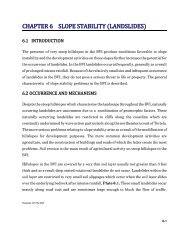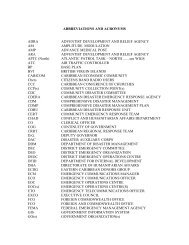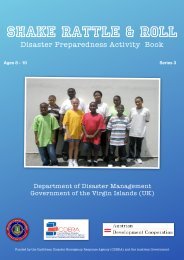Developers
Homeowners Handbook - The Department of Disaster Management
Homeowners Handbook - The Department of Disaster Management
- No tags were found...
Create successful ePaper yourself
Turn your PDF publications into a flip-book with our unique Google optimized e-Paper software.
Among the common hazardous tasks where hand protection should beprovided are:– operations involving contact with rough, sharp or jagged surfaces;– contact with or splashes from hot, corrosive or toxic substances such asbitumen and resins;– working with vibratory machines such as pneumatic drills where somecushioning of the vibrations is desirable;– electrical work in humid and cold weather.Skin trouble is common in the construction industry. Contact dermatitis is thecommonest type of skin disease. It feels itchy and looks red, scaly andcracked, and can become so bad that it affects your ability to continueworking. Wet cement is one of the main skin hazards, but other substancesinclude tar and pitch, which can cause skin cancer after prolonged exposure,paint thinners, acids for masonry cleaning and epoxy resins. In addition togloves, use barrier creams and wear long-sleeved shirts, full-length trousersand rubber boots.Eye protectionIn industry many eye injuries occur as a result of flying material, dust orradiation when the following jobs are being carried out:– breaking, cutting, drilling, dressing or laying ofstone, concrete and brickwork with hand orpower tools;– chipping and dressing painted or corrodedsurfaces;– cutting off or cutting out cold rivets andbolts;– dry grinding of surfaces with power grinders;– welding and cutting of metals.In some industrial processes there may also be a risk from the spillage,leakage or splashing of hot or corrosive liquids.Some of these hazards can be removed permanently by proper machineguarding, exhaust ventilation or work design. For many hazards, for example,stone cutting or dressing, personal eye protection (goggles, safety glasses orshields) is the only practical solution. Sometimes workers are aware of thedanger they run and the consequences if their eyes are damaged, but do notwear eye protection. This is because the type chosen interferes with vision oris uncomfortable to wear, or is not immediately at hand when needed43










